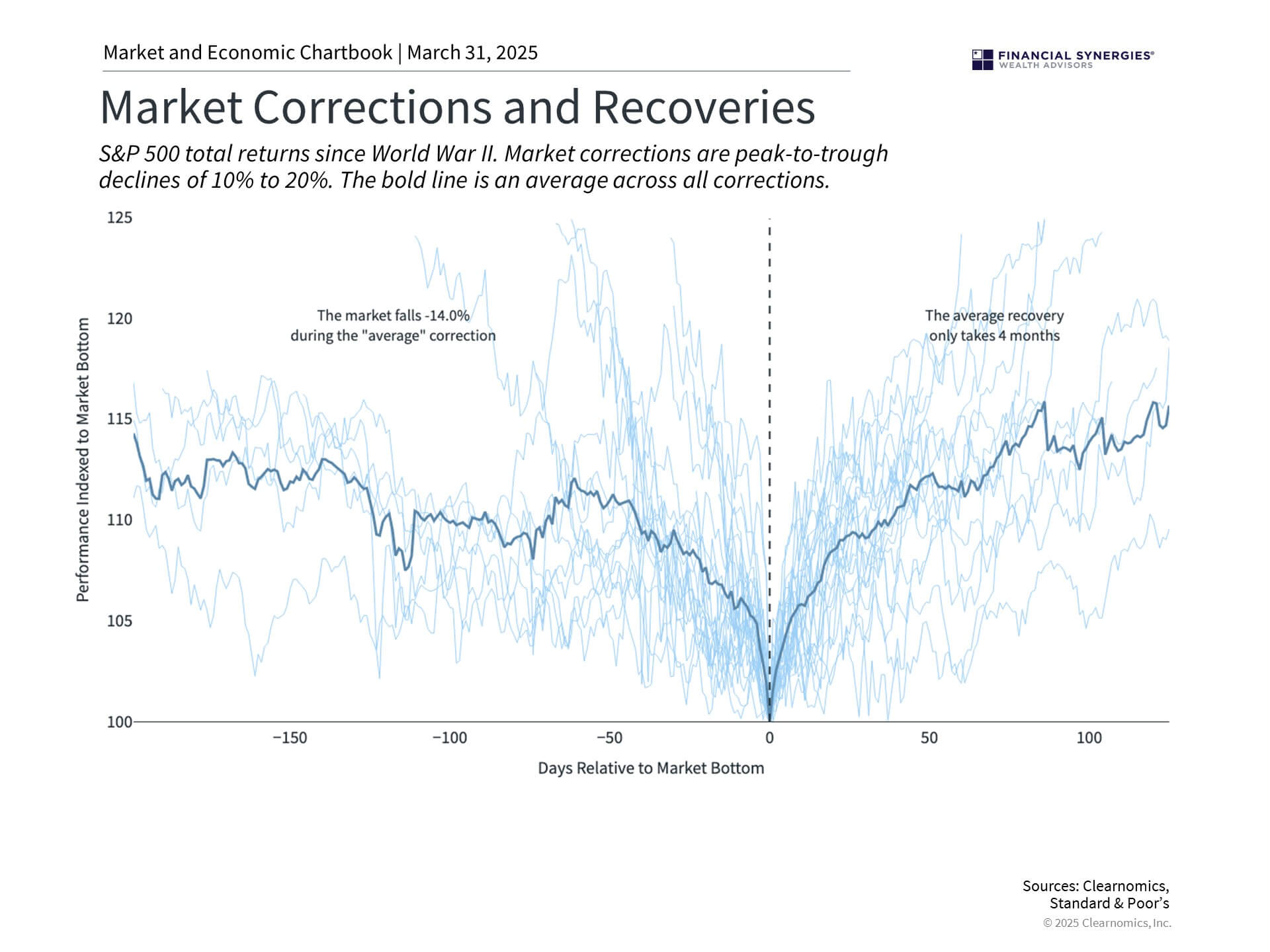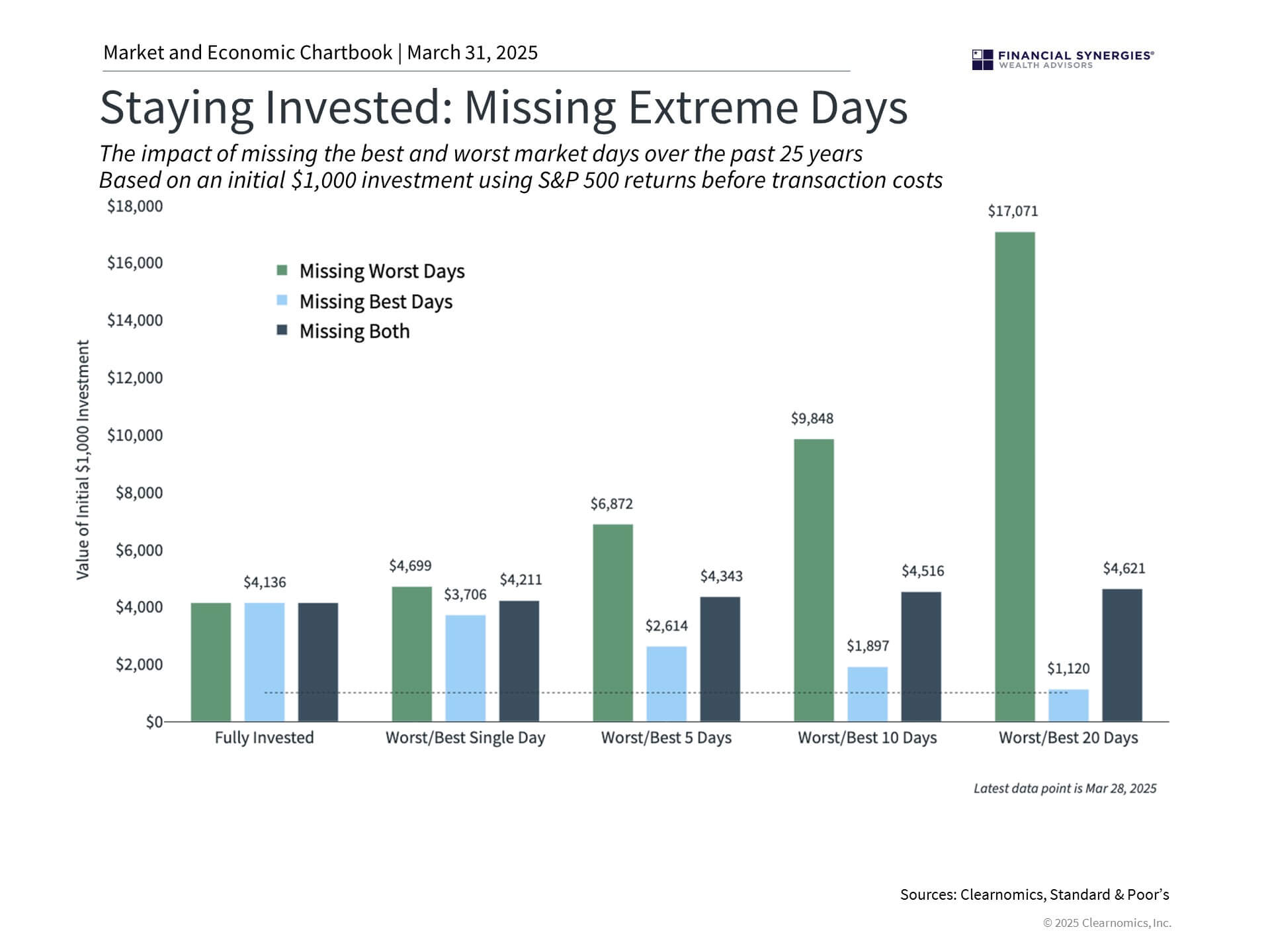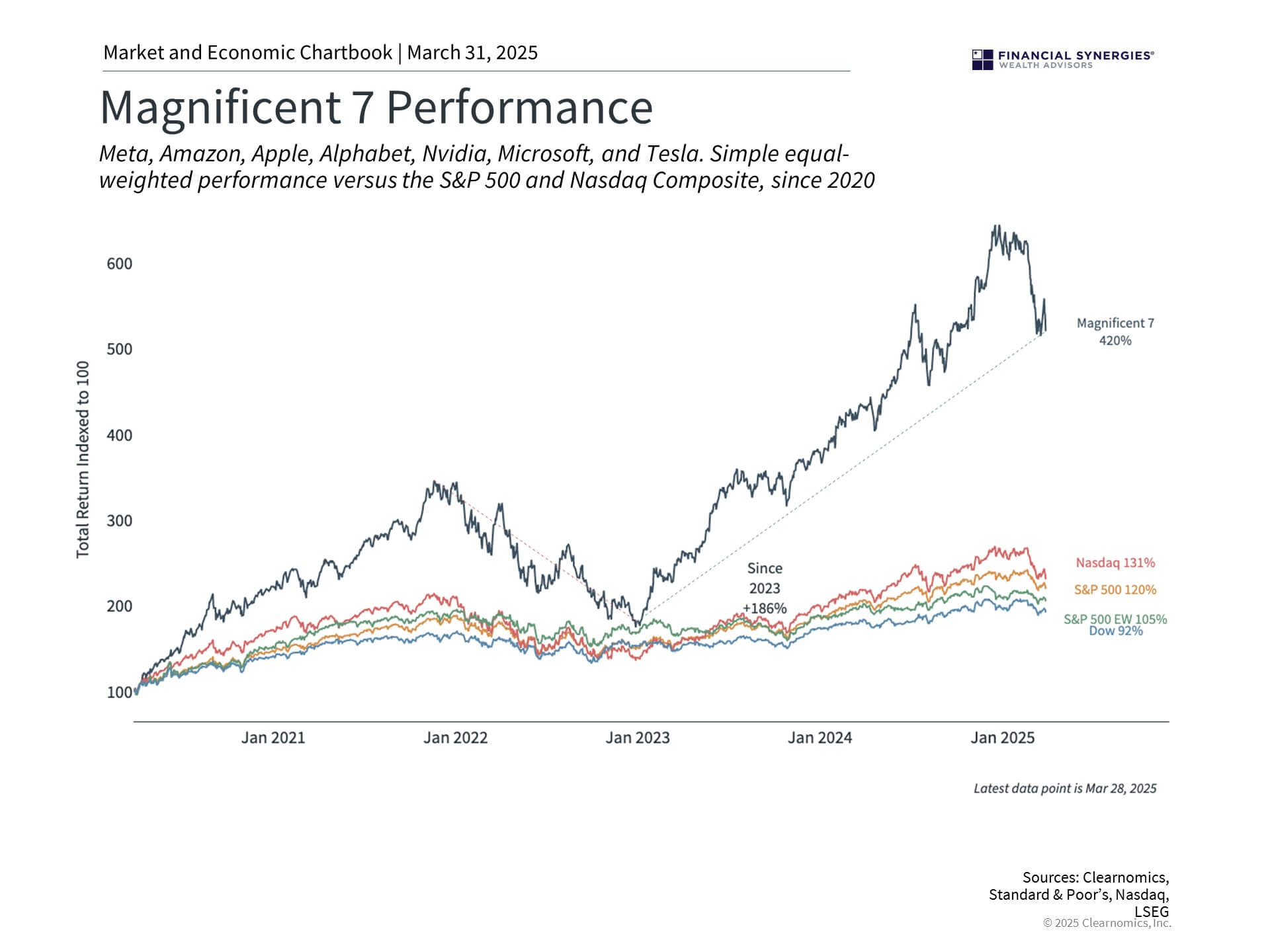With the stock market back near correction territory due to trade war concerns, some investors may feel as if the market is stuck in a “Groundhog Day” loop. Fears of tariffs leading to a trade war have kept markets choppy all year, with the technology sector leading the downturn.
After months of uncertainty, some investors may feel as if financial markets will never stabilize. How can long-term investors maintain perspective in this challenging environment?
Like the seasons, booms and busts are natural parts of the market cycle. Although the winter months may be unpleasant and can seem endless, they eventually give way to warmer weather. So too have market pullbacks historically stabilized, paving the way for expansions and bull markets.
While worries over an escalating trade war make this market correction unique, recent history suggests that it too could eventually turn around once there is greater clarity.
Market pullbacks are normal, and recoveries often occur when they’re least expected

The S&P 500 is near correction territory, defined as a decline of 10% from the prior peak, and the Nasdaq has been in a correction for nearly a month. Economic uncertainty has led to many sizable market swings over the past several weeks, including days where major stock market indices decline by one or two percentage points.

It’s often said that markets take the stairs up and the elevator down. This is because market recoveries tend to be slow moving and compound over time, whereas the events that create short-term fear tend to be sudden, just as they have been this year. At the same time, history shows that even new market lows tend to be higher than previous peaks. In other words, markets often take the stairs up several floors before riding the elevator down one or two levels in a correction.
This is relevant in today’s market since the correction in the S&P 500 is relative to its recent February all-time high. When zooming out, the stock market is only back to where it was last September. So, while unpleasant, it’s important to keep these recent moves in perspective.
As the chart above shows, stock market corrections occur on a regular basis and average 14.3% since World War II. Despite this, major indices have historically recovered in a few months with rebounds often occurring when they’re least expected. Recent examples include the stock market rebounds in mid-2020 during the pandemic, in late 2022 following the tech-led bear market, in early 2023 after the banking crisis, and throughout countless other examples.
Trying to time the market is counterproductive

Instinctively, the nature of up and down periods can lead some investors to try to time the market, seeking safety during down days. Trying to time upswings often backfires, since investors often miss the early parts of a recovery.
Similarly, waiting until markets are already recovering can hurt long-run returns as well. These patterns are highlighted by the accompanying chart which shows the effect of missing the best and worst market days over the past 25 years, and their net effect.
While all investors would like to think they can avoid the worst market days, the truth is that getting this right is extremely difficult, if not impossible. Even in the case when investors can avoid all extreme days, the final outcome is only marginally better than simply staying invested through downturns. This assumes perfect foresight – in reality, investors are often reacting to events that have already occurred.
So, while the past is no guarantee of the future, this is a reminder for investors to stay focused on the long run and not get caught up in short-term market movements.
Tariffs and technology stocks

Investors have grappled with the wide-range of potential outcomes from the administration’s use of tariffs. In many cases, these tariffs are used as a negotiating tactic to bolster positions on other issues such as immigration. In the short run, the fear of higher prices has already impacted consumer sentiment and inflation concerns. In theory, significant escalation, including retaliatory tariffs from trade partners, could slow the global economy in the medium term.
While there is significant uncertainty today as to how tariffs will take shape, the true economic impact of trade unfolds over a longer timeframe. It takes many quarters to fully understand how companies will adjust their sourcing strategies, whether costs are absorbed or passed on to consumers, and how trading partners respond with potential retaliatory measures.
In the meantime, the technology stocks which drove markets higher in the last several years have led market declines, as shown in the accompanying chart. It’s important to view these recent moves in the context of the full cycle, with Magnificent 7 stocks having risen significantly over this period. When investors say that some stocks and sectors are more volatile, these significant ups-and-downs are exactly what they mean.
At the same time, many other sectors have performed better over the past several months including Energy, Healthcare, Utilities, Financials, and others. Over the past year, eight of the eleven S&P 500 sectors are in positive territory, despite recent swings. This underscores the importance of investing across many parts of the market, in balanced portfolios that are aligned with financial plans.
The bottom line? Market volatility has increased on tariff news, with technology stocks experiencing a challenging period. There have been difficult market days recently, and there will be more, but history shows that focusing on the long run is still the best way to achieve financial goals.
Concerns or questions about how your investment portfolio will hold up in the current market environment? Contact Financial Synergies today.
We are a boutique, financial advisory and total wealth management firm with over 35 years helping clients navigate turbulent markets. To learn more about our approach to investment management please reach out to us. One of our seasoned advisors would be happy to help you build a custom financial plan to help ensure you accomplish your financial goals and objectives. Schedule a conversation with us today.
More relevant articles by Financial Synergies:
Blog Disclosures
This content, which contains security-related opinions and/or information, is provided for informational purposes only and should not be relied upon in any manner as professional advice, or an endorsement of any practices, products or services. There can be no guarantees or assurances that the views expressed here will be applicable for any particular facts or circumstances, and should not be relied upon in any manner. You should consult your own financial advisors as to legal, business, tax, and other related matters concerning any investment.
The commentary in this “post” (including any related blogs, videos, and social media) reflects the personal opinions, viewpoints, and analyses of the Financial Synergies Wealth Advisors, Inc. employees providing such comments, and should not be regarded as the views of Financial Synergies Wealth Advisors, Inc. or its respective affiliates or as a description of advisory services provided by Financial Synergies Wealth Advisors, Inc. or performance returns of any Financial Synergies Wealth Advisors, Inc. client.
Any opinions expressed herein do not constitute or imply endorsement, sponsorship, or recommendation by Financial Synergies Wealth Advisors, Inc. or its employees. The views reflected in the commentary are subject to change at any time without notice.
Nothing on this website constitutes investment or financial planning advice, performance data or any recommendation that any particular security, portfolio of securities, transaction or investment strategy is suitable for any specific person. It also should not be construed as an offer soliciting the purchase or sale of any security mentioned. Nor should it be construed as an offer to provide investment advisory services by Financial Synergies Wealth Advisors, Inc.
Any mention of a particular security and related performance data is not a recommendation to buy or sell that security. Financial Synergies Wealth Advisors, Inc. manages its clients’ accounts using a variety of investment techniques and strategies, which are not necessarily discussed in the commentary. Investments in securities involve the risk of loss. Past performance is no guarantee of future results.
Any charts provided here or on any related Financial Synergies Wealth Advisors, Inc. personnel content outlets are for informational purposes only, and should also not be relied upon when making any investment decision. Any indices referenced for comparison are unmanaged and cannot be invested into directly. As always please remember investing involves risk and possible loss of principal capital; please seek advice from a licensed professional. Any projections, estimates, forecasts, targets, prospects and/or opinions expressed in these materials are subject to change without notice and may differ or be contrary to opinions expressed by others. Information in charts have been obtained from third-party sources and data, and may include those from portfolio securities of funds managed by Financial Synergies Wealth Advisors, Inc. While taken from sources believed to be reliable, Financial Synergies Wealth Advisors, Inc. has not independently verified such information and makes no representations about the enduring accuracy of the information or its appropriateness for a given situation. All content speaks only as of the date indicated.
Financial Synergies Wealth Advisors, Inc. is a registered investment adviser. Advisory services are only offered to clients or prospective clients where Financial Synergies Wealth Advisors, Inc. and its representatives are properly licensed or exempt from licensure. Investments in securities involve the risk of loss. Past performance is no guarantee of future results.
See Full Disclosures Page Here
The Trade War Groundhog Day
With the stock market back near correction territory due to trade war concerns, some investors may feel as if the market is stuck in a “Groundhog Day” loop. Fears of tariffs leading to a trade war have kept markets choppy all year, with the technology sector leading the downturn.
After months of uncertainty, some investors may feel as if financial markets will never stabilize. How can long-term investors maintain perspective in this challenging environment?
Like the seasons, booms and busts are natural parts of the market cycle. Although the winter months may be unpleasant and can seem endless, they eventually give way to warmer weather. So too have market pullbacks historically stabilized, paving the way for expansions and bull markets.
While worries over an escalating trade war make this market correction unique, recent history suggests that it too could eventually turn around once there is greater clarity.
Market pullbacks are normal, and recoveries often occur when they’re least expected
The S&P 500 is near correction territory, defined as a decline of 10% from the prior peak, and the Nasdaq has been in a correction for nearly a month. Economic uncertainty has led to many sizable market swings over the past several weeks, including days where major stock market indices decline by one or two percentage points.
It’s often said that markets take the stairs up and the elevator down. This is because market recoveries tend to be slow moving and compound over time, whereas the events that create short-term fear tend to be sudden, just as they have been this year. At the same time, history shows that even new market lows tend to be higher than previous peaks. In other words, markets often take the stairs up several floors before riding the elevator down one or two levels in a correction.
This is relevant in today’s market since the correction in the S&P 500 is relative to its recent February all-time high. When zooming out, the stock market is only back to where it was last September. So, while unpleasant, it’s important to keep these recent moves in perspective.
As the chart above shows, stock market corrections occur on a regular basis and average 14.3% since World War II. Despite this, major indices have historically recovered in a few months with rebounds often occurring when they’re least expected. Recent examples include the stock market rebounds in mid-2020 during the pandemic, in late 2022 following the tech-led bear market, in early 2023 after the banking crisis, and throughout countless other examples.
Trying to time the market is counterproductive
Instinctively, the nature of up and down periods can lead some investors to try to time the market, seeking safety during down days. Trying to time upswings often backfires, since investors often miss the early parts of a recovery.
Similarly, waiting until markets are already recovering can hurt long-run returns as well. These patterns are highlighted by the accompanying chart which shows the effect of missing the best and worst market days over the past 25 years, and their net effect.
While all investors would like to think they can avoid the worst market days, the truth is that getting this right is extremely difficult, if not impossible. Even in the case when investors can avoid all extreme days, the final outcome is only marginally better than simply staying invested through downturns. This assumes perfect foresight – in reality, investors are often reacting to events that have already occurred.
So, while the past is no guarantee of the future, this is a reminder for investors to stay focused on the long run and not get caught up in short-term market movements.
Tariffs and technology stocks
Investors have grappled with the wide-range of potential outcomes from the administration’s use of tariffs. In many cases, these tariffs are used as a negotiating tactic to bolster positions on other issues such as immigration. In the short run, the fear of higher prices has already impacted consumer sentiment and inflation concerns. In theory, significant escalation, including retaliatory tariffs from trade partners, could slow the global economy in the medium term.
While there is significant uncertainty today as to how tariffs will take shape, the true economic impact of trade unfolds over a longer timeframe. It takes many quarters to fully understand how companies will adjust their sourcing strategies, whether costs are absorbed or passed on to consumers, and how trading partners respond with potential retaliatory measures.
In the meantime, the technology stocks which drove markets higher in the last several years have led market declines, as shown in the accompanying chart. It’s important to view these recent moves in the context of the full cycle, with Magnificent 7 stocks having risen significantly over this period. When investors say that some stocks and sectors are more volatile, these significant ups-and-downs are exactly what they mean.
At the same time, many other sectors have performed better over the past several months including Energy, Healthcare, Utilities, Financials, and others. Over the past year, eight of the eleven S&P 500 sectors are in positive territory, despite recent swings. This underscores the importance of investing across many parts of the market, in balanced portfolios that are aligned with financial plans.
The bottom line? Market volatility has increased on tariff news, with technology stocks experiencing a challenging period. There have been difficult market days recently, and there will be more, but history shows that focusing on the long run is still the best way to achieve financial goals.
Concerns or questions about how your investment portfolio will hold up in the current market environment? Contact Financial Synergies today.
We are a boutique, financial advisory and total wealth management firm with over 35 years helping clients navigate turbulent markets. To learn more about our approach to investment management please reach out to us. One of our seasoned advisors would be happy to help you build a custom financial plan to help ensure you accomplish your financial goals and objectives. Schedule a conversation with us today.
More relevant articles by Financial Synergies:
Blog Disclosures
This content, which contains security-related opinions and/or information, is provided for informational purposes only and should not be relied upon in any manner as professional advice, or an endorsement of any practices, products or services. There can be no guarantees or assurances that the views expressed here will be applicable for any particular facts or circumstances, and should not be relied upon in any manner. You should consult your own financial advisors as to legal, business, tax, and other related matters concerning any investment.
The commentary in this “post” (including any related blogs, videos, and social media) reflects the personal opinions, viewpoints, and analyses of the Financial Synergies Wealth Advisors, Inc. employees providing such comments, and should not be regarded as the views of Financial Synergies Wealth Advisors, Inc. or its respective affiliates or as a description of advisory services provided by Financial Synergies Wealth Advisors, Inc. or performance returns of any Financial Synergies Wealth Advisors, Inc. client.
Any opinions expressed herein do not constitute or imply endorsement, sponsorship, or recommendation by Financial Synergies Wealth Advisors, Inc. or its employees. The views reflected in the commentary are subject to change at any time without notice.
Nothing on this website constitutes investment or financial planning advice, performance data or any recommendation that any particular security, portfolio of securities, transaction or investment strategy is suitable for any specific person. It also should not be construed as an offer soliciting the purchase or sale of any security mentioned. Nor should it be construed as an offer to provide investment advisory services by Financial Synergies Wealth Advisors, Inc.
Any mention of a particular security and related performance data is not a recommendation to buy or sell that security. Financial Synergies Wealth Advisors, Inc. manages its clients’ accounts using a variety of investment techniques and strategies, which are not necessarily discussed in the commentary. Investments in securities involve the risk of loss. Past performance is no guarantee of future results.
Any charts provided here or on any related Financial Synergies Wealth Advisors, Inc. personnel content outlets are for informational purposes only, and should also not be relied upon when making any investment decision. Any indices referenced for comparison are unmanaged and cannot be invested into directly. As always please remember investing involves risk and possible loss of principal capital; please seek advice from a licensed professional. Any projections, estimates, forecasts, targets, prospects and/or opinions expressed in these materials are subject to change without notice and may differ or be contrary to opinions expressed by others. Information in charts have been obtained from third-party sources and data, and may include those from portfolio securities of funds managed by Financial Synergies Wealth Advisors, Inc. While taken from sources believed to be reliable, Financial Synergies Wealth Advisors, Inc. has not independently verified such information and makes no representations about the enduring accuracy of the information or its appropriateness for a given situation. All content speaks only as of the date indicated.
Financial Synergies Wealth Advisors, Inc. is a registered investment adviser. Advisory services are only offered to clients or prospective clients where Financial Synergies Wealth Advisors, Inc. and its representatives are properly licensed or exempt from licensure. Investments in securities involve the risk of loss. Past performance is no guarantee of future results.
See Full Disclosures Page Here
Recent Posts
Why Investors Can Be Thankful in 2025
Weekly Market Recap | Nov. 21, 2025
Chart of the Month | S&P 500 Sets More Than 35 New Highs for Second Consecutive Year
Subscribe to Our Blog
Shareholder | Chief Investment Officer